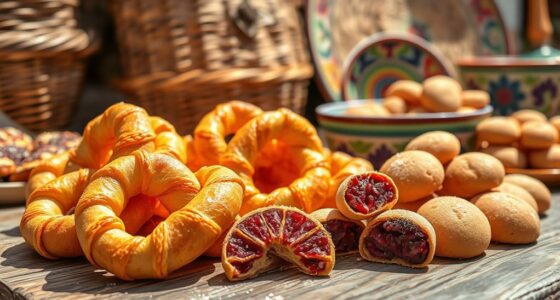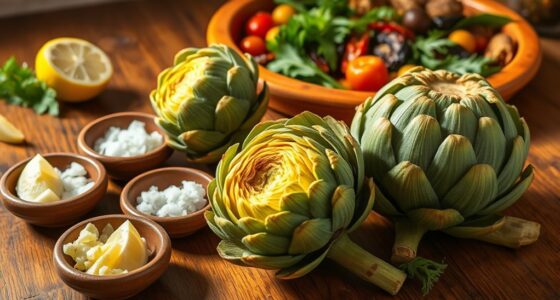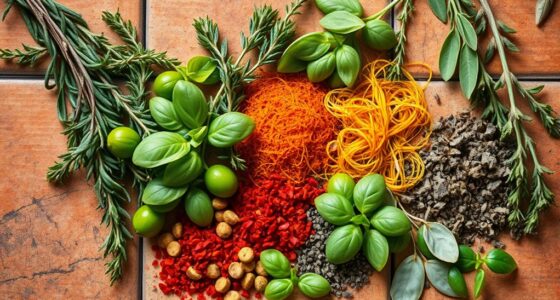Sardinian meat preservation combines traditional methods like salting, air-drying, and curing with natural ingredients such as mineral-rich seawater and local herbs. You’ll find meats and fish covered in sea salt, hung in cool, ventilated spaces, or cured outdoors in sea breezes. Slow cooking and fermentation also play key roles in tenderizing and flavoring. To explore how these techniques sustain authentic flavors and culture, keep exploring these fascinating Sardinian traditions.
Key Takeaways
- Sardinians traditionally use salt curing, applying dry sea salt and natural mineral-rich seawater to preserve pork and fish.
- Air-drying in well-ventilated, cool environments like cellars extends meat shelf life through natural dehydration.
- Herbs, sea water, and minimal additives enhance flavor and antimicrobial properties during curing and preservation.
- Gentle slow cooking and flavor infusion through stewing and marinating tenderize meat while preserving nutrients.
- Whole animal utilization, including offal, supports sustainable practices through curing, drying, and storing various parts.
Salting: The Traditional Sardinian Method of Preservation
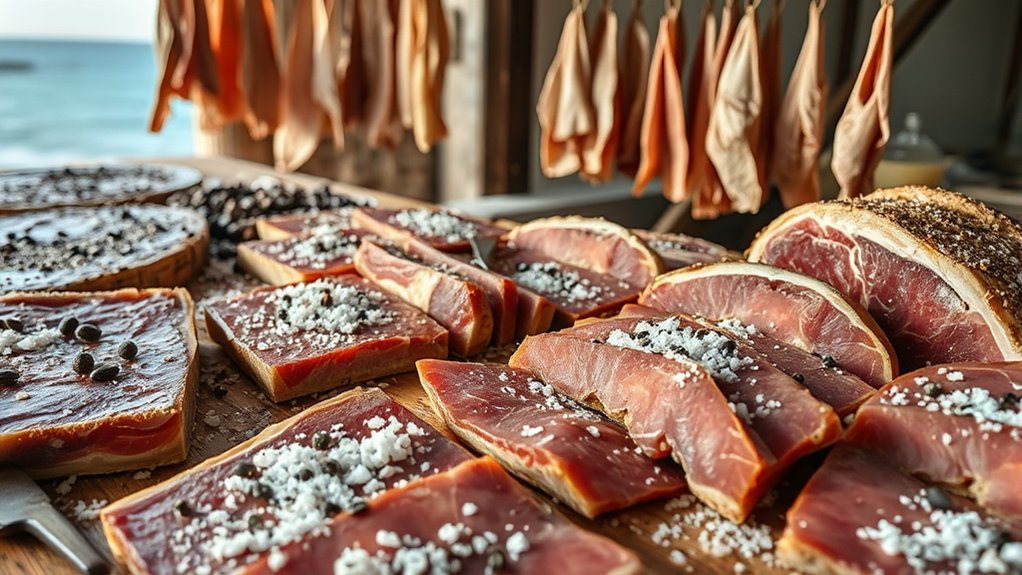
Have you ever wondered how Sardinians have preserved meat for generations? The answer lies in their traditional salting method called “conservazione sotto sale.” You cover the meat entirely with dry salt, which draws out moisture, slows bacterial growth, and extends shelf life. This technique is mainly used for pork cuts like loin, shoulder, and ham, as well as fish. You repeatedly rub coarse sea salt onto the meat over days or weeks, sometimes adding wood ash or saltpetre to boost preservation and color. The salt’s dryness is essential, often harvested locally for its mineral content. Environmental factors like cool, dry conditions and sea breezes help dry the meat naturally. Salt’s natural properties are responsible for this time-honored process not only preserves but also intensifies the meat’s flavor, forming a fundamental part of Sardinian culinary heritage. Additionally, traditional tools such as wooden troughs and clay containers are often used in the process to enhance the preservation method.
Air-Drying and Curing of Meats and Fish
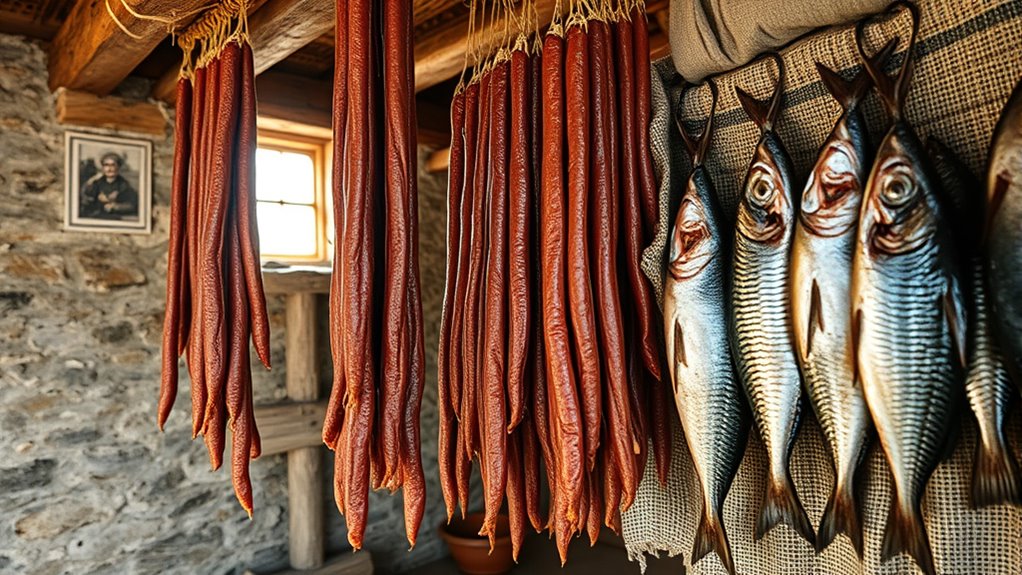
In Sardinia, traditional air-drying and curing methods rely on natural airflow and environmental conditions to preserve meats and fish. You hang meat, such as pork or wild game, in well-ventilated, cool spaces like cellars or stone rooms, where steady air currents flow. The drying process lasts weeks to months, depending on the meat and conditions, with careful control of humidity and temperature to prevent spoilage. Regular inspections remove excess moisture and monitor mold. For fish, like tuna, salting and brief outdoor drying in sea breezes create a flavorful, preserved product. Using natural elements—air, sea, herbs—these methods concentrate flavors, inhibit microbes, and produce tender, aromatic meats and fish. Properly cured Sardinian meats can be stored without refrigeration for extended periods due to the natural preservation process. – Balance of airflow, humidity, and temperature is key. – Slow drying enhances flavor and texture. – Natural antiseptics like sea air and herbs support preservation. Additionally, environmental conditions play a crucial role in ensuring a successful curing process by influencing the rate of drying and microbial activity.
Harnessing Natural Ingredients and Sea Water for Preservation

You can enhance your meat preservation by using Sardinian seawater, which is rich in minerals that help retain natural flavors and textures. Incorporating local herbs and spices not only adds distinctive taste but also boosts antimicrobial properties, reducing the need for artificial preservatives. Embracing these natural ingredients connects you to traditional methods that respect the environment and preserve food authenticity. Sardinian seawater’s mineral richness contributes to maintaining the meat’s freshness and natural qualities over time. Additionally, utilizing traditional preservation techniques can further improve the durability and flavor of preserved meats.
Natural Sea Salt Usage
Harnessing natural sea salt from Sardinian coastlines plays an essential role in traditional meat preservation. This coarse, mineral-rich salt, harvested through sun and wind evaporation, is prized for its purity and natural qualities. It’s preferred over refined salts because its texture and trace minerals support slow curing, helping to preserve meat without additives. When you use Sardinian sea salt, you’re embracing a sustainable practice that maintains the region’s culinary heritage and supports artisanal traditions. The salt’s coarse crystals draw out moisture via osmosis, inhibiting bacteria and extending shelf life. This method not only preserves meats but also enhances their flavor over time, reflecting Sardinia’s resourcefulness and deep-rooted food culture.
- Supports sustainable, artisanal practices rooted in tradition
- Enhances flavor and texture through natural curing processes
- Reinforces Sardinia’s cultural identity and culinary heritage
Mineral-Rich Seawater Benefits
Natural Sardinian seawater offers a wealth of minerals that considerably enhance meat preservation. Rich in magnesium, calcium, potassium, and trace elements, it naturally inhibits microbial growth on meat surfaces, reducing spoilage without artificial additives. The mineral balance boosts osmotic pressure, helping retain moisture within the meat, which keeps it tender and juicy. These minerals also strengthen muscle fibers, preventing drying and toughness during curing. Their antimicrobial properties create an environment hostile to bacteria, extending shelf life naturally. Additionally, the minerals enhance flavor, amplifying natural sweetness and briny notes, while preserving authentic Mediterranean taste profiles. Using seawater aligns with Sardinian traditions, emphasizing ecological, chemical-free preservation methods that support sustainable practices. This natural approach maintains the cultural identity of Sardinian meats while ensuring safety, quality, and flavor. Moreover, the presence of essential minerals in seawater contributes to the overall nutritional profile of preserved meats, adding value for consumers seeking healthful options.
Local Herbs and Flavors
How do local herbs and sea water work together to preserve Sardinian meats? You harness the natural antibacterial and flavor-enhancing properties of herbs like rosemary, thyme, bay leaves, wild fennel, and juniper berries, which inhibit bacteria and add depth. Sea water, with its natural salt and minerals, balances the meat’s moisture, maintains texture, and develops a seaside flavor without chemicals. This combination creates a preservation environment rooted in tradition, emphasizing authenticity and eco-friendliness. By using herbs rich in antimicrobial qualities alongside mineral-rich seawater, you extend shelf life while preserving the meat’s natural taste. This method reflects Sardinia’s resourcefulness and respect for local ingredients. Sea water also contains trace elements that support the preservation process, which further enhances its effectiveness. Additionally, the natural salt content in seawater acts as a preservative, helping to inhibit microbial growth.
Slow Cooking and Stewing: Tenderizing and Preserving Flavors
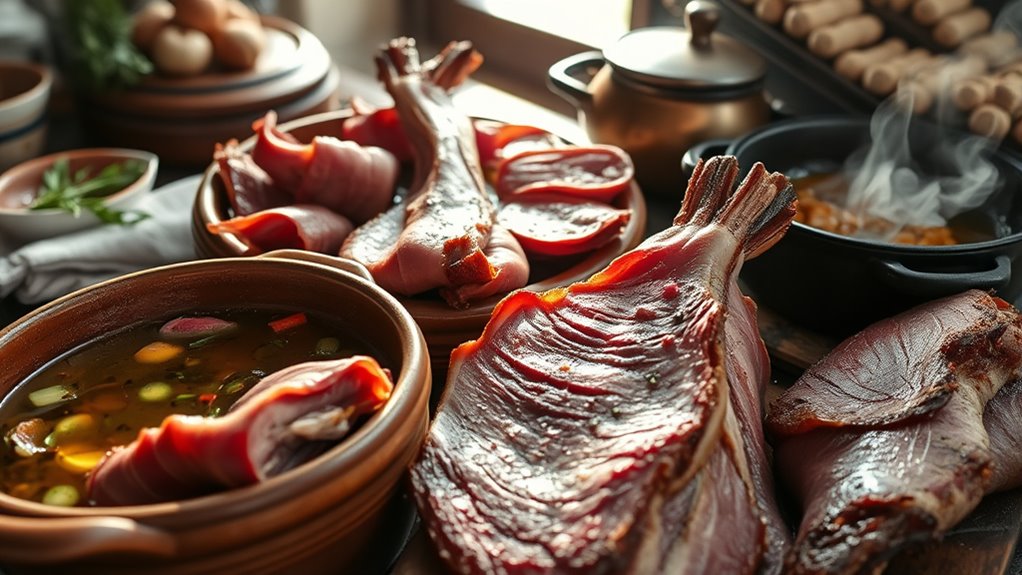
When you slow cook or stew meat, you apply gentle heat that breaks down tough fibers while locking in moisture. This controlled process allows flavors from herbs, spices, and local ingredients to infuse deeply into the meat. By managing temperature and cooking time carefully, you preserve the meat’s tenderness and enhance its natural taste. Slow cooking also minimizes nutrient loss, ensuring the dish remains rich in flavor and nutritional value. Additionally, this technique can be part of traditional meat preservation techniques, maintaining quality over time.
Gentle Heat Application
Applying gentle, consistent heat through slow cooking and stewing is essential for tenderizing tough meats and preserving their rich flavors. By maintaining low, steady temperatures, you prevent muscle fibers from contracting, which keeps the meat tender and juicy. Covering the pot tightly traps moisture, ensuring even heat distribution and flavor retention. This method allows connective tissues to break down gradually, transforming tough cuts like mutton or hare into melt-in-your-mouth dishes. Longer simmering times, often over an hour and a half, maximize tenderness without risking dryness. Using controlled heat, such as low stovetop or sous vide, enhances flavor infusion and nutrient preservation. This approach not only tenderizes but also locks in the natural, robust flavors that are central to Sardinian culinary tradition. Proper temperature control ensures even heat distribution for consistent results. Prevents overcooking and dryness by controlling temperature. Slow cooking techniques enhance flavor and nutrient retention through slow, steady heat.
Flavor Infusion Techniques
Slow cooking and stewing are powerful techniques for infusing rich flavors into meat while tenderizing it. By cooking at low temperatures over extended periods, tough connective tissues break down, resulting in tender, easy-to-chew meat. During this process, herbs, spices, and wine deeply penetrate the fibers, enhancing flavor. Using ingredients like garlic, rosemary, and juniper berries, you can infuse the meat with aromatic notes. Stewing involves immersing meat in a flavorful liquid—broth, wine, or sauce—that captures and concentrates these aromatics. Heavy clay or cast iron pots distribute heat evenly, maximizing flavor infusion. Proper temperature control is essential to prevent spoilage during long cooking times. Additionally, the slow cooking process allows for flavor absorption, ensuring the meat takes on the full profile of the seasonings used. Cooling the meat in its sauce before storage further amplifies taste. These techniques, rooted in Sardinian tradition, ensure both tender, flavorful meat and effective preservation.
Fermentation and Sausage Making: Extending Shelf Life Naturally

Fermentation and sausage making have long been natural methods to extend meat shelf life while enhancing flavor. By drying and fermenting sausages, you create an environment that inhibits spoilage microbes and promotes beneficial bacteria. This process not only preserves the meat but also develops rich, complex flavors. When preparing Sardinian sausages, you use ingredients like wild fennel, garlic, chili, and red wine, which contribute antimicrobial properties and flavor. Hanging the sausages to dry for at least 10 days ensures fermentation and proper seasoning. Proper shaping and casing support uniform drying and flavor development. Natural fermentation relies on lactic acid bacteria, enhancing preservation. Herbs and spices provide antimicrobial benefits, boosting shelf life. Controlled drying concentrates flavors and extends usability without refrigeration. [The low moisture content achieved through drying further inhibits bacterial growth, ensuring safety and longevity.
Whole Animal Utilization and Preservation of Offal
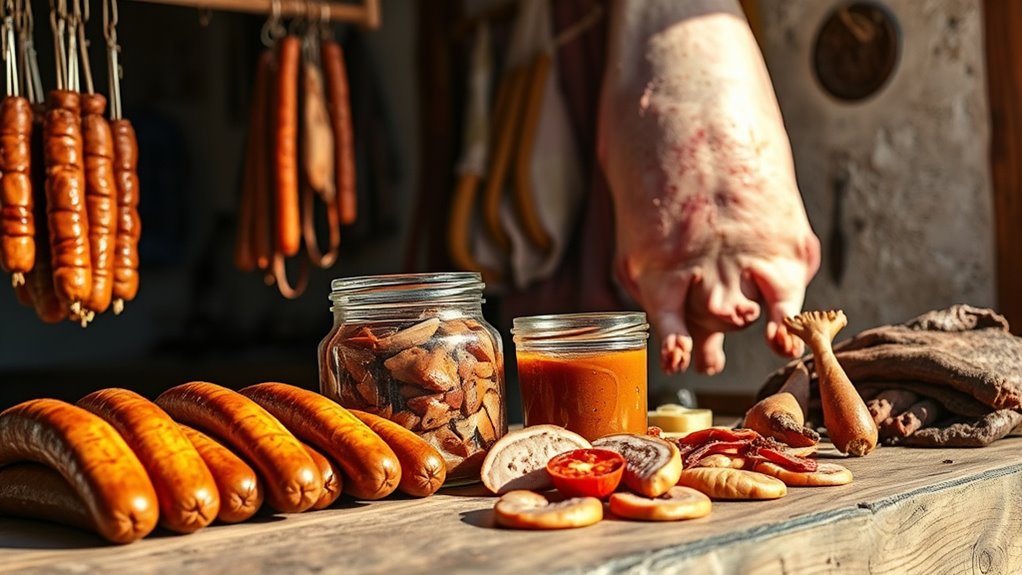
In Sardinia, using the entire animal reflects a deep cultural respect for resourcefulness and sustainability. You’ll find that organs like liver, heart, lungs, and even brains are incorporated into daily meals, showcasing a nose-to-tail eating philosophy. Offal such as tongue and stomach are common ingredients in traditional recipes, often prepared as stews or cured products. Preservation techniques include turning scraps into sausages or curing fatty cuts with sea salt, drying, and controlled humidity. These methods extend shelf life through sweating, drying, and storage in specialized cellars. Offal is a crucial protein source, appreciated for its flavor and nutrients, and its utilization connects Sardinians to their agricultural roots. Immediate processing and careful handling ensure quality, making offal an integral part of their resourceful culinary heritage. Additionally, traditional STEM-based preservation methods like controlled humidity and temperature help maintain offal quality over time.
The Role of Herbs and Spices in Enhancing Preservation
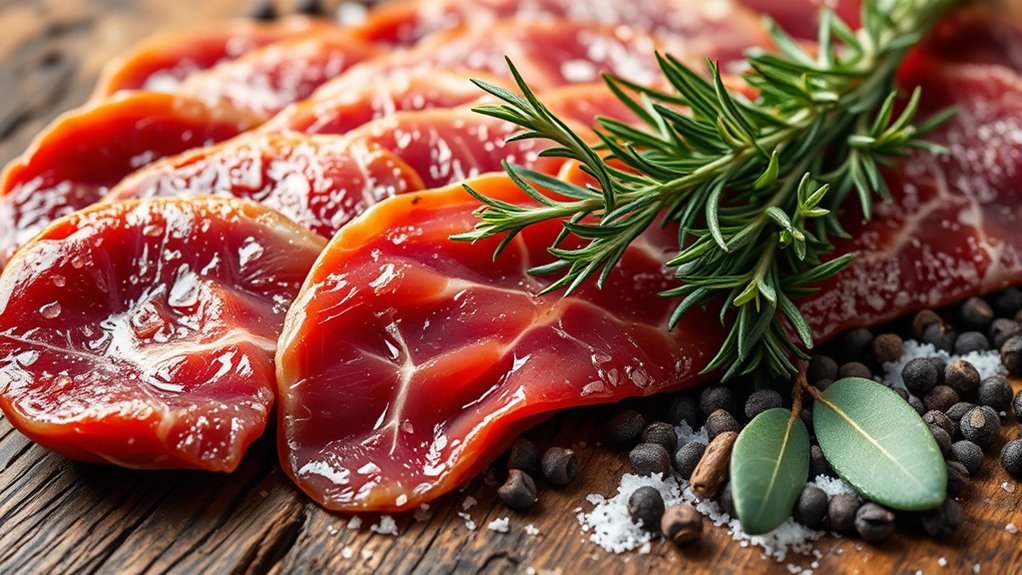
Herbs and spices play a vital role in Sardinian meat preservation by enhancing both flavor and safety. They contain natural antimicrobial and antioxidant properties that slow spoilage and rancidity. For example, black pepper and garlic help inhibit bacteria, while wild fennel seeds and thyme add aromatic layers and prevent microbial growth. Incorporating herbs during slow-cooking or salt curing allows flavors to penetrate deeply, extending shelf life. Regional spices like myrtle, rosemary, and saffron boost preservation through their antimicrobial and antioxidant effects, making each product unique. Using herb blends standardizes flavor and enhances safety. Herbs like garlic and thyme inhibit bacteria and pathogens. Antioxidants in herbs slow lipid oxidation, delaying rancidity. Aromatic herbs mask off-odors and improve sensory appeal. Natural antimicrobial properties help preserve meat longer.
Unique Sardinian Techniques: Using Mineral-Rich Seawater
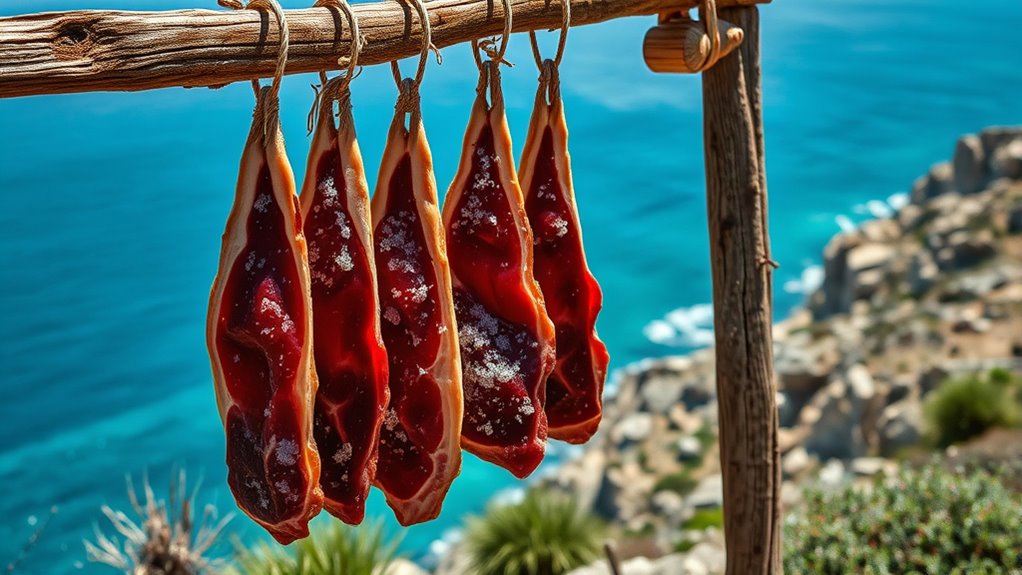
Herbs and spices considerably enhance Sardinian meat preservation by adding flavor and protecting against microbial growth. Beyond these, Sardinian seawater offers a unique preservation method due to its mineral-rich composition. Its natural purity and minimal pollutants make it an ideal medium, containing minerals like magnesium, calcium, and trace elements that support preservation. The seawater’s balanced salinity preserves moisture and prevents drying out, keeping the meat tender and flavorful. Its minerals help stabilize proteins, maintaining texture and locking in subtle tastes like sweetness and briny freshness. Used mainly for seafood, such as blue crab, the seawater is applied immediately after harvest, often with minimal processing. This method aligns with Sardinia’s slow-food philosophy, emphasizing natural, local resources over chemicals or artificial additives. The seawater’s mineral content also contributes to antimicrobial properties, helping to inhibit the growth of bacteria and extend the freshness of the meat.
Cultural Significance of Preservation Methods in Sardinian Society
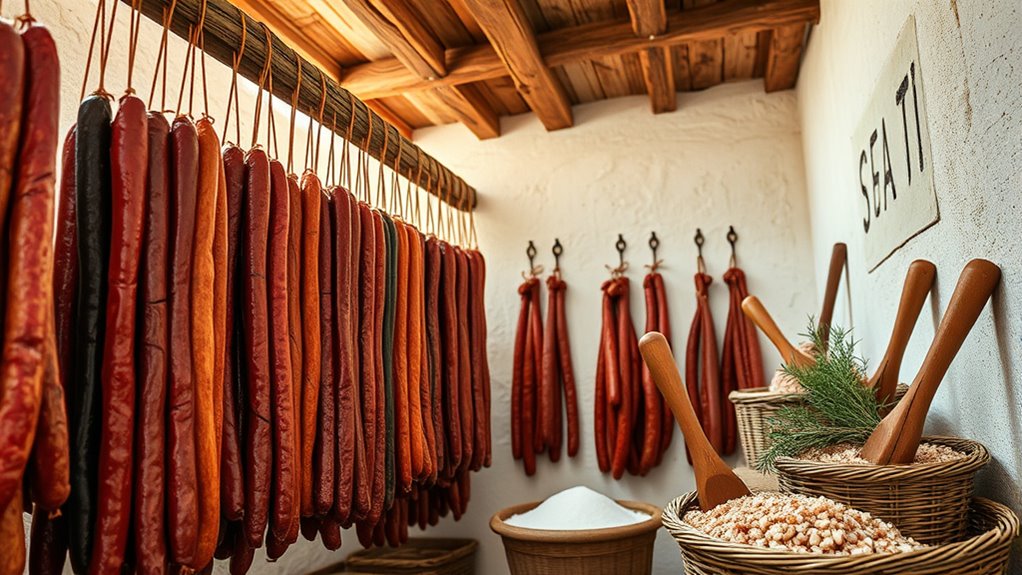
The methods Sardinian communities have developed for meat preservation are deeply rooted in their history and social fabric. These techniques symbolize resilience, resourcefulness, and a strong bond with land and tradition. They foster community identity through shared rituals, like collective slaughtering and festive feasts, reinforcing social cohesion. Preserved meats are more than food; they’re symbols of heritage, craftsmanship, and regional pride. Recipes and methods vary by family and village, strengthening micro-identities. The act of preserving sustains knowledge transmission across generations, maintaining cultural continuity. These practices also support local economies by enabling trade and tourism, preserving traditional skills. Overall, Sardinian meat preservation methods serve as tangible links to history, community, and cultural pride.
- Foster social bonds through communal rituals and festivals
- Embody regional identity and ancestral craftsmanship
- Support local economies and the transmission of skills
Frequently Asked Questions
How Does Salt Specifically Inhibit Bacterial Growth in Sardinian Preservation?
You ask how salt inhibits bacterial growth, and here’s the answer. Salt reduces water activity by binding water molecules, making them unavailable for bacteria. It creates osmotic pressure, causing dehydration and plasmolysis in bacterial cells. This disrupts their cellular functions and slows or stops growth. In Sardinian preservation, salt also works with drying and smoking to further inhibit microbes, ensuring meat stays safe and develops rich flavors.
What Environmental Conditions Are Ideal for Air-Drying Meats in Sardinia?
Did you know Sardinian air-drying takes place at elevations between 200 and 800 meters? You need stable temperatures of 10-20°C and humidity levels around 65-80% for ideal drying. Gentle, consistent airflow is essential, often harnessed from sea breezes or mountain winds. Seasonal timing is vital—autumn and winter provide the perfect climate, helping prevent spoilage and ensuring your meat develops rich flavor and texture naturally.
Which Natural Herbs Are Most Commonly Used in Sardinian Curing Processes?
You want to know which herbs are most common in Sardinian curing. You’ll find myrtle, fennel, rosemary, laurel, and sage used frequently. These herbs bring aromatic oils that penetrate the meat, enhancing flavor naturally. You’ll also notice garlic, black pepper, chili, cumin, and paprika often added for depth and spice. Together, these herbs create the unique, traditional taste that defines Sardinian cured meats.
How Does Seawater Preserve Blue Crab Without Artificial Additives?
You wonder how seawater preserves blue crab without artificial additives. Seawater preserves by creating a natural, hypertonic environment that draws moisture out of microbes, inhibiting their growth. It also slows spoilage through osmotic dehydration, reducing water activity. Additionally, trace minerals in seawater may offer antimicrobial benefits. This traditional method relies on natural salinity, environmental conditions, and careful timing to extend freshness without chemicals, making it a simple yet effective preservation technique.
What Role Do Traditional Sardinian Techniques Play in Modern Sustainable Practices?
You see, traditional Sardinian techniques play a crucial role in modern sustainability by emphasizing natural methods that reduce energy use and waste. By relying on salt, seawater, drying, and fermentation, you help lower environmental impact, avoid artificial additives, and support local resources. These practices promote biodiversity, minimize packaging, and encourage seasonal, local eating, aligning with eco-friendly values and ensuring the preservation of culinary heritage for future generations.
Conclusion
You might think traditional Sardinian preservation methods are outdated, but they actually highlight your connection to nature and sustainable practices. By embracing techniques like salting, air-drying, and using natural ingredients, you guarantee authentic flavors and reduce reliance on artificial preservatives. These time-tested methods prove that preserving food can be both effective and respectful of tradition. So, why not explore Sardinian techniques and bring a touch of their heritage into your own kitchen?



